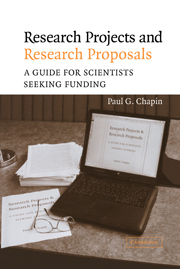Book contents
- Frontmatter
- Contents
- Foreword
- Acknowledgments
- Introduction
- 1 Selecting a Research Topic
- 2 Project Planning
- 3 Identifying Funding Sources
- 4 Special Funding Mechanisms
- 5 Writing a Proposal
- 6 Research Ethics and Responsibilities
- 7 The Natural History of a Proposal
- 8 “We Are Happy/Sorry to Inform You …”
- 9 Managing Your Grant
- Appendix A Glossary of Acronyms
- Appendix B Useful URLs
- Index
4 - Special Funding Mechanisms
Published online by Cambridge University Press: 14 July 2009
- Frontmatter
- Contents
- Foreword
- Acknowledgments
- Introduction
- 1 Selecting a Research Topic
- 2 Project Planning
- 3 Identifying Funding Sources
- 4 Special Funding Mechanisms
- 5 Writing a Proposal
- 6 Research Ethics and Responsibilities
- 7 The Natural History of a Proposal
- 8 “We Are Happy/Sorry to Inform You …”
- 9 Managing Your Grant
- Appendix A Glossary of Acronyms
- Appendix B Useful URLs
- Index
Summary
If you convened a focus group of people experienced in the world of funding scientific research and asked them for a basic definition of the term “grant,” you'd probably come up with something like the following: a sum of money awarded to an institution to enable one or two investigators to work for two or three years on a particular scientific question, the award being based on an evaluation of the scientific merits of a research proposal. At one time that was the model for the overwhelming majority of the grants from the government agencies we surveyed in the previous chapter, and it is the model that is implicit in a lot of the discussion in this book.
In recent years, however, the funding agencies, especially the NSF, have incorporated some additional policy objectives into their funding activities and have instituted some special funding mechanisms to help reach those objectives. We will explore some of those mechanisms in this chapter, concentrating on the NSF, but with some attention to the NIH as well.
The special mechanisms have varying purposes. Some aim at supporting particular groups of researchers – such as new investigators, or women, or members of ethnic minority groups that are underrepresented in the community of active researchers – in an effort to enlarge and diversify that community. Others present opportunities for support of alternative models of research management, such as large multi-investigator centers or industry—university collaboration.
- Type
- Chapter
- Information
- Research Projects and Research ProposalsA Guide for Scientists Seeking Funding, pp. 43 - 60Publisher: Cambridge University PressPrint publication year: 2004



